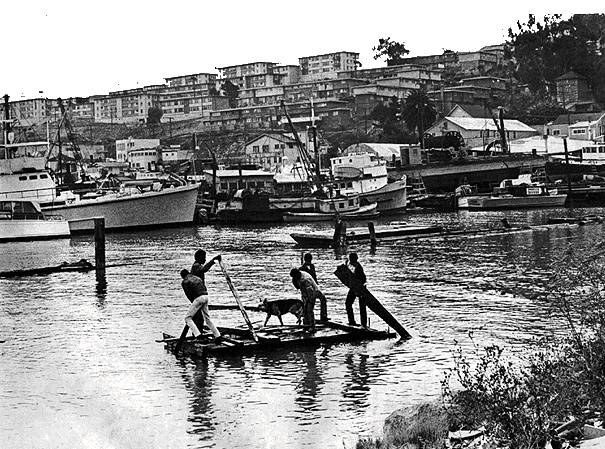India Basin and the Southeast Bayshore: Difference between revisions
No edit summary |
m (1 revision(s)) |
(No difference)
| |
Revision as of 13:49, 7 October 2007
India Basin c. 1969.
During the spring of 1998 I wandered through the derelict lands of Pier 98, a twenty-five acre peninsula that juts out into the bay under the imposing shadow of the massive PG&E Hunters Point Power Plant at the end of Evans Avenue. Among the acres of pampas grass and yellow star-thistle I found a small patch of native wildflowers that are otherwise rare in San Francisco. In the middle of what most would perceive as an industrial wasteland, how did these ever survive?
The call of a killdeer interrupted such thoughts, reminding me that birds have a more discerning eye. They recognize the resilience of nature, the persistence of natural processes. Storm waves erode the edges of the bay fill and plant fragments and seeds float in with the tides to convert abandoned landfill back to bay lands. Tidal marshes formed in this way are a shadow of their former selves, but they provide habitat just the same to hungry shorebirds or mating Killdeer. In the waters and upland edges of India Basin at least 118 bird species have been seen; 21 species, including American Avocet and Killdeer, are confirmed nesters (Hopkins 1996).
Back to the ecological mystery: how did the rare wildflowers blossom forth from a weedy landfill? It is likely that they came in with the fill itself, in this case serpentine rock and soil brought in from nearby Hunters Point or Potrero Hill. The native goldfields, lupine, and clovers had persisted here ever since the fill was first placed in the mid-1970s. As weeds and motor bikes invaded the site they may have steadily lost habitat, finding refuge only in the harshest serpentine soils that kept most weeds from invading. During the El Nio winter of 1998 they burst forth. Only the bees, searching for pollen, knew that their siblings were miles away in the serpentine slopes of Hunters Point and Potrero Hill.
When the Port of San Francisco first proposed a 48-acre bay fill project in the late 1960s, it planned to place clean sand and dredged bay mud on the site instead of serpentine rock and wood debris. They received a permit in 1970 from the Bay Conservation and Development Commission (BCDC) to begin filling the subtidal bay lands by pointing to the economic benefits. The project, known as Pier 98, was meant to serve container ships and anchor the western end of a proposed Southern Bay Bridge. By 1977, when the Port aborted the project and halted construction of the pier, container ships had mostly deserted San Francisco for Oakland and the Southern Crossing was dead.
In the fifteen years it took for the BCDC and the Port to resolve their differences about the legality of the bay fill, Pier 98 became a valuable recreational resource for the citizens of Hunters Point and the Bayview district. It also became habitat as storm waves and tidal action eroded the fill along the southern edge. A complex of tidal wetlands and intertidal ponds developed; after decades of absence, marsh plants could once again be found in San Francisco.
In its agreement with BCDC, the Port agreed to expand the tidal marsh, cap sections of the site that had received illegal fill (wood material, construction debris, etc.), and provide more amenities for recreational users. In 1999 the wetlands were expanded to 9 acres in a partnership between the Port, City College, local schools, and the San Francisco League of Urban Gardeners. It was christened Herons Head by someone who noticed its resemblance in aerial photos to the Great Blue Heron that are commonly seen in the area.
Tidal inundation and erosion have created other tidal marshes in fill along the edge of derelict industrial lands at Pier 94, Yosemite Channel, and elsewhere along the shoreline of Hunters Point. In the future the city may provide additional recreational opportunities and expand tidal marshes along the southeast bayshore.
-- Pete Holloran
References:
Levine-Fricke-Recon. 1997. Alternatives analysis report, Pier 98, Wetlands and Open Space Project. Prepared for the Port of San Francisco.
Contributors to this page include:
San Francisco Bay Guardian,San Francisco,CA - Publisher or Photographer
SF Recreation and Parks Dept. - Photographer-Artist

